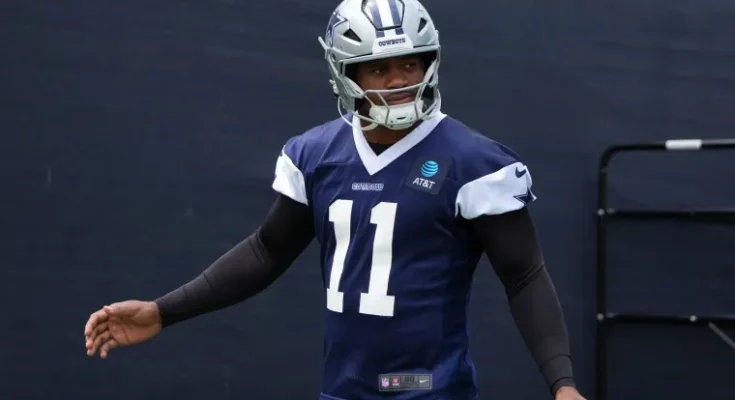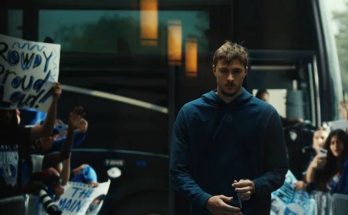The contract extension saga surrounding Micah Parsons, the Dallas Cowboys’ dynamic linebacker, has become a significant talking point within NFL circles, sparking widespread criticism of the Cowboys organization. This controversy, which has unfolded over several months, has not only raised questions about the franchise’s handling of its star players but also exposed underlying tensions between the team’s management and its core talent. As one of the most explosive and versatile defenders in the league, Parsons’ situation has taken on a much larger significance, shining a spotlight on the Cowboys’ approach to player relations, salary cap management, and long-term team building.
Micah Parsons quickly established himself as one of the premier defensive players in the NFL since his rookie season. Drafted in the first round of the 2021 NFL Draft, Parsons wasted no time making an impact with his speed, strength, and relentless pursuit. His ability to disrupt offenses, whether through pass rushing, run stopping, or coverage, made him an immediate game-changer. In fact, his rookie year was so impressive that many analysts and fans expected the Cowboys to prioritize locking him down to a long-term deal, given his young age and potential to remain a cornerstone of their defense for years to come.
However, despite Parsons’ meteoric rise and undeniable importance to the team, contract negotiations between him and the Cowboys have been notably protracted and fraught with complications. The situation quickly escalated into a saga that brought about major criticism from fans, media pundits, and even some former players. The criticism largely centers around the perception that the Cowboys have mishandled the process, undervaluing Parsons’ contributions and failing to act with urgency to secure one of the league’s most valuable defensive assets.
At the heart of the issue is the delay in agreeing to an extension. Typically, teams are motivated to secure their standout young players early to avoid costly holdouts or distractions. The Cowboys, however, seemed content to prolong discussions even as Parsons continued to deliver elite performances on the field. This delay raised eyebrows and led to frustration among supporters who believed the franchise was risking unnecessary turmoil just to save a few million dollars or preserve salary cap flexibility in the short term.
The criticism intensified as reports surfaced about the nature of the Cowboys’ proposed offers and Parsons’ responses. Many believed the offers were not reflective of Parsons’ market value, especially given the linebacker’s role as a defensive centerpiece and his leadership qualities. The league has seen a rising trend of top defensive players commanding significant contracts, and Parsons’ skill set and impact clearly place him in that upper echelon. Critics argued that the Cowboys’ reluctance to meet his demands demonstrated a lack of respect for his talents and an unwillingness to reward excellence appropriately.
Moreover, the handling of the contract talks seemed to damage the relationship between Parsons and the Cowboys’ front office. In professional sports, trust and good faith negotiations are essential for maintaining a positive environment. Yet, the drawn-out nature of these talks suggested a breakdown in communication and mutual understanding. Some insiders speculated that the Cowboys’ management may have underestimated Parsons’ leverage and the potential consequences of allowing negotiations to drag on. Such miscalculations can lead to player dissatisfaction, distractions during the season, and even potential holdouts, which can hurt the team’s on-field performance and reputation.
Adding fuel to the fire, the Cowboys’ history with star players and contract disputes came under renewed scrutiny. This situation was seen by many as part of a pattern where the franchise struggles to effectively negotiate with its marquee talents. The high-profile and often publicized holdouts or tensions with key players have been a recurring theme for Dallas, and the Parsons saga seemed to reinforce this negative perception. For fans who have witnessed other talented Cowboys endure prolonged contract battles, the Parsons case felt like a missed opportunity to break away from an all-too-familiar narrative.
Another angle of criticism involved the strategic implications for the Cowboys’ defense and overall team competitiveness. Parsons is not just a top-tier player; he is a transformational piece around which a defense can be built. By allowing the contract situation to become contentious, the Cowboys risked creating instability within the defensive unit and potentially compromising their chances of sustained success. The extended negotiations took attention away from football and put a spotlight on off-field drama, which is rarely conducive to a winning culture. Analysts pointed out that such distractions could have ripple effects, impacting locker room morale and even influencing how other players perceive the organization’s commitment to its talent.
From a broader NFL perspective, the Micah Parsons contract saga also sparked debate about how teams value and compensate defensive players relative to offensive stars, especially quarterbacks. While Parsons’ skills are undeniable, the Cowboys’ cautious approach was seen by some as symptomatic of a league-wide challenge where defensive players often have to push harder to get contracts commensurate with their impact. This situation reignited conversations about fairness, market dynamics, and how franchises balance salary cap pressures with the need to retain elite talent on both sides of the ball.
The Cowboys’ handling of Parsons’ contract also opened up questions about their front office’s long-term strategy. With a salary cap that is always a juggling act, the decision to delay or negotiate hard on Parsons’ deal might reflect a prioritization of flexibility for other positions or impending roster needs. However, critics argued that such a strategy might be shortsighted if it risks alienating a player as valuable as Parsons. The potential cost of losing or distracting him could far outweigh the benefits of preserving cap space in the near term.
As the saga unfolded, it also became a public relations challenge for the Cowboys organization. Fans, analysts, and even Parsons himself used social media and interviews to express their feelings, opinions, and frustrations. The public nature of the dispute added pressure on the Cowboys to come to an agreement quickly and with terms favorable enough to keep Parsons happy. The longer the saga persisted, the more the franchise’s reputation took a hit, portraying them as hesitant or out of touch with the value of their defensive star.
Eventually, the Cowboys did manage to reach a contract extension with Micah Parsons, but the journey to that point left a lasting impression. The episode served as a case study in how contract negotiations for elite players can become complex, emotionally charged, and subject to intense public scrutiny. It also highlighted the delicate balance teams must maintain between fiscal prudence and rewarding performance adequately to retain cornerstone players.
In reflecting on the Parsons contract extension saga, one can see it as more than just a negotiation over money. It symbolized the broader challenges facing NFL franchises as they attempt to build competitive teams while managing salary caps, player expectations, and fan loyalty. For the Cowboys, a team with a passionate fanbase and high expectations, the criticism that emerged from this saga underscored the importance of clear communication, timely decisions, and valuing star players not just as athletes but as integral parts of the franchise’s identity.
Ultimately, the Micah Parsons saga serves as a reminder that talent retention in the NFL is about more than just contracts; it is about relationships, trust, and respect. While the Cowboys may have successfully extended Parsons’ deal, the criticism that accompanied the process will likely influence how the franchise approaches future negotiations with its stars. For fans and analysts alike, this saga remains a cautionary tale of what can happen when negotiations drag on too long, and a reminder of the value of keeping the team’s most important players front and center in the organization’s priorities.



